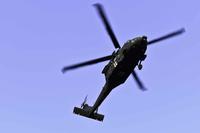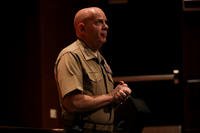Maj. Gen. Ed Thomas sat on a mattress pad in the closet of his study as movers shuffled boxes around his on-base Texas home in late May. It was the 23rd and final move of his more than 30-year career in the Air Force.
Thomas retired on Friday. For the past three years, he has been the commander of the Air Force Recruiting Service, or AFRS. His successor, sworn in Friday, is Brig. Gen. Christopher Amrhein, who previously served as vice commander of the 19th Air Force at Joint Base San Antonio-Randolph, Texas.
In June 2020, Thomas was given the difficult task of bringing in new airmen and Space Force Guardians amid the COVID-19 pandemic. Despite those unprecedented times, his team managed to meet their recruiting goals each year.
Read Next: Defense Secretary Orders No Drag Shows on Military Bases After Political Furor
But, sitting on his closet floor as he prepared to leave military service and hand over the reins, Thomas came to a realization: The service's recruiting crisis is worse than previously thought. With recruiting numbers this year below even what Air Force leaders expected, the difficult job of bringing in new recruits now falls to Amrhein, who spoke to Military.com about his plans in an exclusive interview.
"It's been sporty," Thomas told Military.com as movers scurried around his house. "This has been undoubtedly the most difficult recruiting environment that we've had since the all-volunteer force began back in 1973."
In March, Air Force Secretary Frank Kendall announced at the Air and Space Force Association's conference in Colorado that the service is projecting about a 10% shortfall in active-duty numbers and the hole will likely be even larger for the Guard and Reserve.
Two months later, Thomas said that the situation looks even more dire than previously thought.
He told Military.com that the shortfall will be "around 13% on the active-duty side, and we're still around 30% on the Guard and Reserve."
Thomas said Air Force recruiting was able to adapt during the height of the pandemic and use virtual technology to meet its goals the last three years, but that long-standing problems, such as a lack of face-to-face contact between potential recruits and recruiters, have caught up with them.
"Two years of not doing those things and not having those personal connections and not having those opportunities for those recruiters to practice those skills caught up with us," he said.
Amrhein, who acknowledged the difficulties ahead, said he’s optimistic despite the headwinds.
"Without question, it's a challenging time," Amrhein said. "It's a challenging time for, you know, all recruiting across the Department of Defense. But, in the same breath, I would say I'm not discouraged."
AI, THC and Gen Z
The Air Force Recruiting Service has been working hard to turn the tide. It has issued at least six policy changes or new initiatives aimed at recruiting just since January.
These include offering medals and promotions for recruiting; streamlining the naturalization process so recruits can become citizens during basic military training; offering reserve bonuses for prior-service airmen; reinstating the Enlisted College Loan Repayment Program; allowing certain tattoos on the hands and neck; and unveiling a new smartphone feature that allows airmen to send info on almost anyone to a recruiter.
"That speaks to the speed at which, I believe, the Air Force is responding as a service to get after some of those potential barriers or provide additional incentives," Amrhein said.
Prior to taking over command, Amrhein didn't want to say which of those recently approved programs has had the most success. But he said there likely won’t be any “silver bullet” that will overcome the depressed recruiting numbers.
Amrhein said the Air Force could look to artificial intelligence, or AI, for help.
From the moment a civilian walks off the street to the point they're sitting on a bus headed to basic training can be a long process. Amrhein said using AI could smooth out that process, help increase communication with recruits, and reduce the overall time it takes.
"There are some things within customer service that I think AI is going to help and has already helped," he said.
But no technology can change some of the factors that the Air Force Recruiting Service is facing when it comes to finding new recruits.
The U.S. has seen some of its lowest unemployment rates in more than 50 years. Added to that, the Pentagon has released studies showing that only 23% of American youth are eligible to serve due to being overweight, using drugs, or having mental and physical health problems.
The Air Force Recruiting Service said that, overall, less than 10% of the young population is interested in serving in the first place – 50% can't even name all the military service branches.
Amrhein told Military.com that his personal story of joining the military is now an anomaly. His father enlisted in the Air Force, eventually became an officer and flew for the majority of his career. Amrhein says that, when he joined the service in the mid-'90s, he estimates about 45% of children had a parent who served in some way in the military. That number has dipped to 15%, he added.
"I also realize that touchpoint has gotten a little bit farther and farther away over time," Amrhein said. "With less than 1% of our population that is likely ever to serve in uniform, we have to get that story out there."
Many of those statistics are defining the Air Force's recruiting strategy for Generation Z, Americans born between the mid-1990s and the early 2010s. Thomas told Military.com that updating technology to cut down the time it takes to get a new recruit into uniform is crucial.
"A 'hurry-up-and-wait' mentality is no longer an effective way to connect with Generation Z," Thomas said. "We cannot do that. A 'hurry-up-and-wait' mentality does not work for Generation Z, and we've got to be able to adapt."
Thomas and Amrhein agreed that policies must adapt. One change being considered relates to candidates who test positive for THC, the main psychoactive component in marijuana, as marijuana legalization becomes more common across the country.
In late September, the Air Force and Space Force announced a new pilot program that would grant certain applicants -- ones who are otherwise perfect candidates -- who test positive for THC a chance to retest and possibly join the ranks. Once in uniform, they cannot test positive or they will face punishment.
In the first three months the program was in place -- between Sept. 30 and Dec. 31 -- the Air Force Recruiting Service granted 43 applicants who tested positive for THC a chance to retest. Thomas told Military.com that, in his opinion, it's likely to become a permanent policy.
"I believe the THC pilot will be codified in the policy," Thomas said. "We are in a place where 38 of 50 states have legalized marijuana and the chance of inadvertent exposure or other exposure that would have been previously permanently disqualifying. [It] simply does not make sense in today's environment."
But with any of these changes, critics -- ranging from older veterans to conservative lawmakers -- are likely to accuse the military of changing its standards, becoming soft or weak.
Amrhein and Thomas said those comments are expected but, the way they see it, those policy updates don't change the Air Force's mission.
"I think our message has been pretty darn consistent that we are not lowering standards," Amrhein said. "Does that mean that there aren't changes? Well, as an Air Force, we have evolved since 1947. In my 27 years that I've been in the Air Force, we've evolved tremendously. How we do things may be a little bit different. But getting the mission done and making sure that we have ready airmen to go support our nation and national defense, I don't think that's changed a bit."
'The Sense of Purpose'
The fiscal year ends Sept. 30, leaving about four months until the Air Force needs to hit its recruiting goals.
Just a 10% shortfall in the active-duty ranks is the equivalent of around 5,000 people, nearly the total of all the airmen at the 366th Fighter Wing stationed at Mountain Home Air Force Base, Idaho.
An April 4 email from Thomas, which was leaked on social media and has been verified as authentic by the service, detailed a dire shortfall in several career fields and predicted nearly 3,000 jobs that could see vacancies.
Thomas estimated that there could be "1,800 empty maintainer jobs, 700 empty defender jobs, 300 in munitions and 100 in fuel" if the recruiting environment doesn't get better.
"In the coming years, our brothers and sisters in arms will be asked to carry the burden intended for teammates who never joined our team," Thomas wrote in the email. "Airmen will almost certainly be asked to work longer hours, cover more shifts and make sacrifices in their personal lives to meet the mission demands essential to our national security."
Lt. Gen. Michael Loh, the director of the Air National Guard, told the Center for a New American Security think tank this week that the reserve component expects to be 4,000 recruits short.
"The further we get into the year, mathematically, the harder it is to catch up," Thomas said. "Even if we had a flood of recruits in the last several months of the year, we have already lost training seats through the entire year."
Katherine Kuzminski, a senior fellow at the Center for a New American Security who researches military culture and family issues, told Military.com that it's not impossible for the Air Force to meet its goals, but agreed with Thomas' view that it gets harder as the clock ticks.
"I think we're still within the realm of possibility, with it being June 1. We've got one more fiscal quarter plus the rest of this month, so that is a third of the fiscal year that we still have left. But part of the projections that they're using to determine the shortfall actually come from last fiscal year when they tapped into the delayed-entry program," she said.
Amrhein says he is ready to take on the challenge. Last month, he saw his daughter commission into the Air Force, making her the third generation in the family to serve. He said he believes others across the country are also ready to answer that call to service.
"Who is this new generation coming in?" Amrhein said. "I would say that they are as eager as I thought I was. They're ready to support our nation. They’re excited about the cause.”
Thomas praised Amrhein's abilities and said he'll be an excellent leader for the Air Force Recruiting Service during a trying time.
Taking a minute to reflect on his more than three decades of military service, Thomas says it'll feel strange to finally be done.
"This has been a remarkable final assignment for me. To be able to have the privilege of being able to change the lives of Americans who come in to serve, and being able to ensure the combat readiness of our Air Force and our Space Force has been the privilege of a lifetime," Thomas said. "I'm going to miss the sense of purpose."
His career has taken him from Alaska to Hawaii and across Europe from Germany to Italy. It's a life and a career he hopes the next generation will also get the chance to experience.
-- Thomas Novelly can be reached at thomas.novelly@military.com. Follow him on Twitter @TomNovelly.











